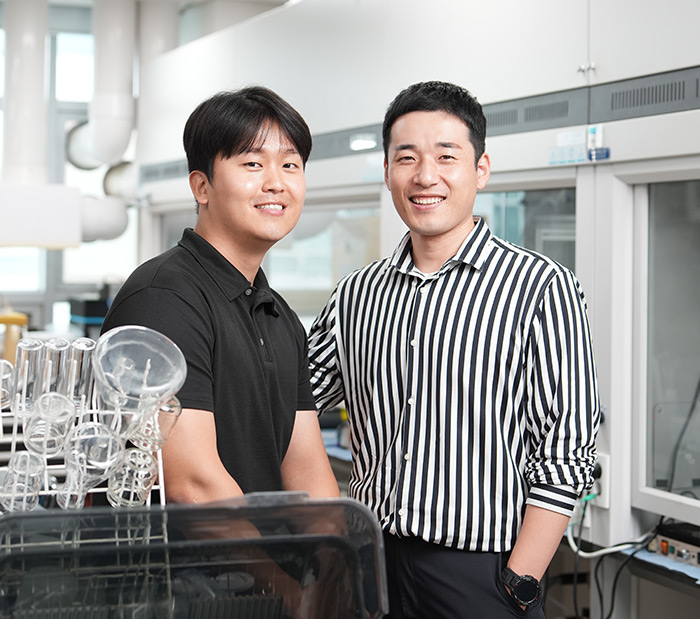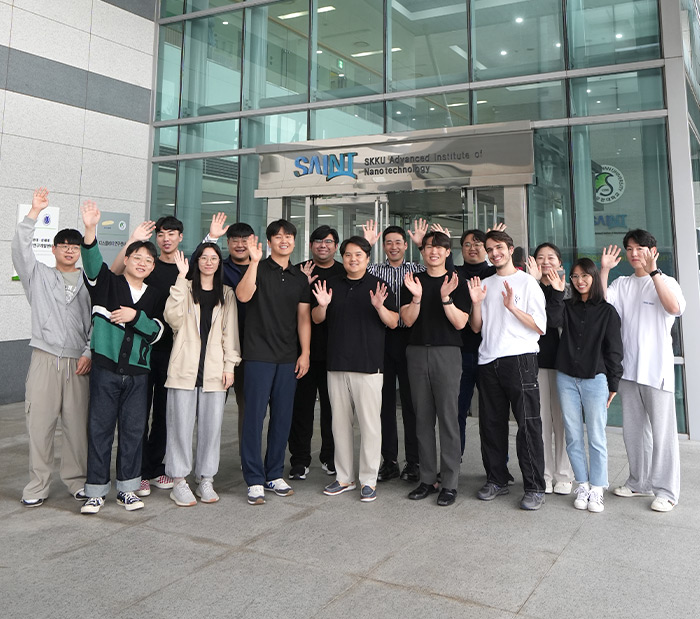Research Stories
SAINT faculty Prof. Seongpil An research team with Highly-sensitive flexible and transparent piezoelectric nanogenerator
Development of a multifunctional nanogenerator capable of detecting microbubble movement and energy harvesting
SKKU Advanced Institute of Nano Technology
Prof.
AN, SEONGPIL
Ph.D. Daekyu Choi, Dr. Hongseok Jo
Sungkyunkwan University (President Jibeom Yoo) and a research team led by Prof. Seongpil An from the SKKU Advanced Institute of Nano Technology (SAINT) has recently developed a highly-sensitive, flexible, and transparent piezoelectric nanogenerator that can detect microbubbles by cavitation inside pipes and also can convert the kinetic energy of these microbubbles into electrical energy.
Piezoelectric nanogenerators, which can be used as a ubiquitous energy source, are considred as a next-generation self-powered energy technology that can addressee energy issues such as fossil fuel depletion and environmental pollution. This research presents that a thin, transparent, and flexible ultra-sensitive piezoelectric nanogenerator was developed using electrospinning, electroplating, electrostatic spraying, and chemical bath deposition techniques. This piezoelectric nanogenerator was engineered to detect micro buoyancy resulting from the physical movement of microbubbles and also efficiently convert it into electrical energy. The research holds promise for the potential application in the plant industry, particularly in systems requiring sensing and energy harvesting of complex piping equipment of various sizes.
※ Cavitation: A phenomenon in which the static pressure of a liquid reduces to below the liquid's vapor pressure, leading to the formation of small vapor-filled cavities in the liquid.
※ Microbubble: Very small bubble with a diameter of approximately less than 100 ㎛.
※ Piezoelectric nanogenerator: An energy harvesting device that can convert external kinetic energy into electrical energy through the action of nanostructured piezoelectric materials.
※ Electrospinning: A fiber production method that uses electric force to draw charged threads of polymer solutions or polymer melts up to fiber diameters in the order of some hundred nanometers.
※ Electrostatic spraying: A voltage-driven process governed by the electrohydrodynamic phenomena where particles are made from a polymer solution.
※ Chemical bath deposition: A method of thin-film deposition (solids forming from a solution or gas), using an aqueous precursor solution.
Prof. An's research team (1st author, Ph.D. student Daekyu Choi, co-1st author Dr. Hongseok Jo) developed a flexible and transparent piezoelectric nanogenerator having outstanding sensitivity. This could be contributed to uniformly grown piezoelectric zinc oxide nanowires on the surface of nickel microfibers with high electrical conductivity. Under an external force of 10 N, this nanogenerator demonstrated a power generation performance of 35 V. Notably, even in the presence of ultra-fine buoyancy as low as 0.009 N by the motion of microbubbles, it exhibited a power generation performance of 0.04 V. Furthermore, it confirmed stable energy-harvesting performance even under conditions where external force was repeatedly applied more than 100,000 times, demonstrating excellent mechanical durability.
Prof. An, corresponding author of this study, added, “Recently, research and development incorporating multidisciplinary science and technology has been actively focused, so innovative research must continue in the future through active exchange of research knowledge between researchers in various fields.”
Lastly, the 1st author of this study, Ph.D. student Daekyu Choi, expressed his intention, “I think that energy-harvesting research, which can transduce kinetic energy wasted in daily life into electrical energy, is a research having enough potential to change the paradigm of the future.” Additionally, co-first author Dr. Hongseok Jo, said, “The highly-sensitive piezoelectric nanogenerator developed here is thought to have a high potential to be used as power sources and sensors for microelectronic devices, so follow-up commercialization research is needed.” The first author of this study, Ph.D. student Daekyu Choi is in the initial phase of doctoral course, and co-first author Dr. Hongseok Jo was recently selected for the ‘National Research Foundation of Korea Creative Challenge Research Project’,. Their outstanding future research activities are highly expected.
This study was supported by the National Research Foundation of Korea (NRF) grant funded by the Korea Government (MSIT) RS-2023-00211303, NRF-2021R1A2C2007141, and 2022M3H4A408507611.
This study was published on Aug. 30th in Advanced Functional Materials (IF: 19), one of the world-renowned academic journals in the top 5% of the material science field.
※ Title: Transparent, Flexible, and Highly Sensitive Piezocomposite Capable of Harvesting and Monitoring Kinetic Movements of Microbubbles in Liquid
(Journal: Advanced Functional Materials, https://onlinelibrary.wiley.com/doi/full/10.1002/adfm.202307607)
Schematic of fabrication process and illustration of microbubble detection experiment, detecting microbubbles that occur inside the pipe.


